SAMSUNG Galaxy S25 Review
Best Ever – But Not Worth Upgrading
I’ve just received the Galaxy S25, the successor to my current daily driver, the Galaxy S24, and the smartphone I was most eagerly anticipating this year.
To be honest, I have zero complaints about my Galaxy S24. Nevertheless, the Galaxy S25 represents Samsung’s ultimate smartphone creation. Coming from a company that stands at the pinnacle of Korea’s chaebols (conglomerates) and accounts for approximately 20% of Korea’s GDP, Samsung essentially embodies Korea itself. This smartphone literally carries the weight of Korea’s pride and reputation, so it simply cannot be anything less than exceptional.
So I took the plunge and purchased it. Here’s my comprehensive review.
Galaxy S25 Key Features
- Industry-leading performance (best of 2025)
- Comprehensive value-added features (mobile payments, water resistance, dual SIM, wireless charging)
- Exceptional battery longevity
- Versatile triple camera system (ultra-wide, wide, telephoto)
- Remarkably slim and lightweight design (even more refined than previous models)
- Intuitive, user-friendly interface
- Outstanding AI capabilities
In essence, the current Galaxy series is virtually flawless. It can rightfully be called the perfect Android smartphone. The user experience surpasses all competitors and comfortably exceeds even the iPhone.
While it deserves greater market success, my primary concern is that the series essentially reached perfection with the Galaxy S23, with minimal noticeable evolution since then. This is precisely what I feared most—a dilemma facing not just the Galaxy lineup but the entire smartphone industry.
Galaxy S25 Detailed Specifications
Here’s how the Galaxy S25 compares to its predecessor, the Galaxy S24:
| Feature | Galaxy S25 | Galaxy S24 |
|---|---|---|
| Display | 6.2-inch (120Hz OLED) | 6.2-inch (120Hz OLED) |
| Resolution | 2340×1080 | 2340×1080 |
| Processor | Snapdragon 8 Elite | Snapdragon 8 Gen 3 |
| Memory | 12GB | 8GB |
| Storage | 256/512GB | 256GB |
| Battery | 4000mAh (Qi2) | 4000mAh (Qi) |
| Security | Fingerprint/Face | Fingerprint/Face |
| Mobile Payment | Yes | Yes |
| Water Resistance | IP68 | IP68 |
| Dual SIM | Yes (eSIM) | Yes (eSIM) |
| Weight | 5.7oz (162g) | 5.9oz (167g) |
| Dimensions | 2.8 x 5.8 x 0.28 in (71 x 147 x 7.2mm) | 2.75 x 5.8 x 0.30 in (70 x 147 x 7.6mm) |
| Price (incl. tax) | $799.99 | $759.99 |
The primary improvements are in the processor, memory, wireless charging standard, and thickness—all representing incremental evolutions that demonstrate commendable engineering effort, though some might characterize them as minimal updates.
Benchmark Performance: Galaxy S25 Scores 2.3 Million on AnTuTu

The Galaxy S25 achieved an impressive 2.31 million points on the AnTuTu v10 benchmark. For context, here’s how it compares to other devices based on Gadget Magazine measurements:
- Galaxy S25: 2,314,873 (Snapdragon 8 Elite)
- Xiaomi 14T Pro: 1,993,091 (Dimensity 9300+)
- iPhone 16 Pro: 1,815,336 (A18)
- Galaxy S24: 1,724,895 (Snapdragon 8 Gen 3)
- iPhone 15 Pro: 1,599,710 (A17 Pro)
- iPhone 14 Pro: 1,434,765 (A16)
- Galaxy S23: 1,422,544 (Snapdragon 8 Gen 2)
- Pixel 9 Pro: 1,224,046 (Tensor G4)
Delivering the highest smartphone performance ever at a $799.99 price point is genuinely praiseworthy. While I’m still searching for applications that can fully utilize this processing power, it’s excellent news for mobile gaming enthusiasts.
I continue to hope that more PC-quality games will make their way to the smartphone platform.
Battery Life: Galaxy S25 Lasts Nearly 23 Hours
![] Galaxy S25 Lasts 22 Hours 56 Minutes](https://dailyedge.net/wp-content/uploads/2025/04/Battery-2-300x221.jpg)
When testing the Galaxy S25’s battery endurance with PC Mark for Android, it took 18 hours and 21 minutes to deplete from 100% to 20% (with brightness set at 110 lux, volume at 50%, in 60Hz display mode). This extrapolates to approximately 22 hours and 56 minutes to completely drain the battery.
Compared to previous devices:
- AQUOS sense9: 21 hours 10 minutes (60Hz)
- Galaxy S25: 18 hours 51 minutes (60Hz)
- Xiaomi 14T Pro: 17 hours 57 minutes (60Hz)
- Pixel 9 Pro: 17 hours 39 minutes (60Hz)
- Galaxy S24: 17 hours 4 minutes (60Hz)
- iPhone 16 Pro: 16 hours 20 minutes (60Hz)
- Nothing Phone: 15 hours 27 minutes
- Galaxy S25: 15 hours 9 minutes (120Hz)
- Galaxy S23: 14 hours 35 minutes (60Hz)
- Galaxy S20: 10 hours 44 minutes ← Phones that last a full day with moderate use
- Galaxy Note20 Ultra: 9 hours 35 minutes
- iPhone12: 8 hours 13 minutes
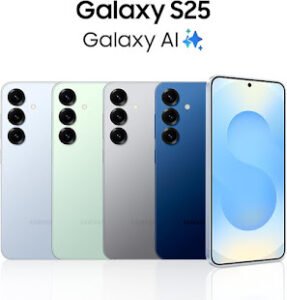 | SAMSUNG Galaxy S25 Cell Phone, 128GB AI Smartphone, Unlocked Android, 2025, US 1 Yr Manufacturer Warranty, Silver Shadow Buy on Amazon |
Achieving nearly 23 hours of battery life with just a 4000mAh capacity battery is remarkable. Coupled with its industry-leading performance, it’s truly impressive engineering. The most notable improvement is compared to the Galaxy S23, which shares the same battery capacity but delivers over 5 hours less runtime—a testament to Samsung’s ongoing optimization efforts.
I recommend using the 60Hz display mode if battery longevity is your priority. With this setting, you can comfortably use the device for two full days on a single charge.
Weight and Design: Galaxy S25 at Just 5.7oz with 4000mAh Battery
It’s particularly impressive that the Galaxy S25 delivers its exceptional performance and battery life in a body weighing just 5.7oz (162g) with a 4000mAh battery.
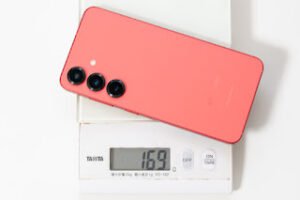
With a glass screen protector added, the weight increases only slightly to 6oz (169g), and remains under 7.1oz (200g) even with a SPIGEN clear case installed.

This combination of lightweight design and high-end performance is a unique selling point of the Galaxy series. Few competitors can match this balance of features and portability.
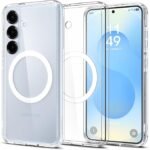 | Spigen Ultra Hybrid MagFit Designed for Galaxy S25 Case [Qi2 Certified/Magnet for Galaxy] (2025) – Clear White Buy on Amazon |
Physical Design: Thinner and More Refined
The Galaxy S25 maintains Samsung’s established design language, with minimal changes from the S23 generation. One welcome improvement is that the Japanese market now receives the same color options as international markets, including more vibrant, diverse options.

While the overall aesthetic remains familiar, the camera bump is slightly more pronounced, lending a more premium feel compared to the Galaxy S24.
![]()
Most notably, the S25 is 0.02 inches (0.4mm) thinner and 0.18oz (5g) lighter than its predecessor. While these differences might seem insignificant on paper, they’re immediately perceptible when handling the device. It’s remarkable how sensitive human perception is to even small changes in dimensions and weight.
Samsung’s commitment to continuous refinement, even in subtle ways, is commendable.
The contrast becomes especially apparent when comparing the S25 to the iPhone 16 Pro, which maintains a noticeably thicker profile. Apple would do well to address this aspect of their Pro models in future iterations.
Here’s how the leading compact flagship models compare: From left to right: Pixel 9 Pro (7oz/199g), iPhone 16 Pro (7oz/199g), Galaxy S25 (5.7oz/162g), Galaxy S24 (5.9oz/167g).

The Galaxy S25 is approximately 37g lighter than both the Pixel and iPhone models, which is a significant difference in daily use. The other interface elements remain largely unchanged from previous generations. The vibrant red accent on the side adds a touch of visual distinction.
As expected, the display quality is impeccable—a standard feature of all premium smartphones in today’s market.
Biometric Security: Fast and Reliable Fingerprint Recognition
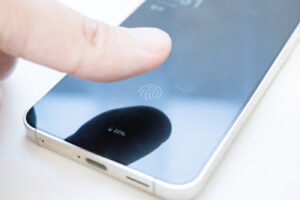
The fingerprint recognition is impressively responsive and accurate (image shows the Galaxy S24 for reference). I’m using a glass screen protector that’s compatible with the ultrasonic fingerprint sensor, and it works flawlessly without any recognition issues.
Charging Capabilities: 25W Wired, 15W Wireless
The Galaxy S25 supports charging speeds of up to 25W via cable and 15W for wireless charging. The inclusion of Qi2 standard support has reportedly improved wireless charging efficiency.
While competitors like Xiaomi offer much faster charging (up to 120W), such extreme speeds likely come at the cost of battery longevity. Given the S25’s 4000mAh battery capacity, the 25W charging provides a reasonable balance between charging speed and battery health.
MagSafe Compatibility
The Galaxy S25 appears to support MagSafe accessories, though reports suggest the magnetic connection might be weaker than Apple’s implementation. Users who prioritize this feature might want to consider a MagSafe-compatible case for more secure attachment. Personally, I don’t use this feature, so it’s not a consideration in my assessment.
Audio Quality: Consistent Performance
The Galaxy S25’s speaker quality remains largely unchanged from the S24. I couldn’t detect any meaningful difference between the two models.
That said, the audio quality is certainly sufficient for everyday use. While it doesn’t quite match the iPhone 16 Pro’s speaker performance, it compares favorably to most other smartphones in the market.
Camera Performance: Galaxy S25 Photo Test
Now for the aspect I was most eagerly anticipating—the Galaxy S25’s camera performance. My expectations were tempered knowing that Samsung hasn’t changed the physical camera hardware in recent generations, meaning any improvements would be software-based.
However, since software processing is increasingly the dominant factor in smartphone photography, there was still reason for optimism.
The Galaxy S25 maintains the same camera configuration as recent models:
- 3x telephoto lens
- Standard wide lens
- Ultra-wide lens
I’ll be comparing it with the iPhone 16 Pro, Pixel 9 Pro, and Galaxy S24. All sample photos were taken handheld without using night mode.
Main Camera: Daylight Photography

In scenes with blue sky and backlighting, the iPhone 16 Pro tends to underexpose, while both the Pixel and Galaxy S25 maintain better dynamic range. The Pixel renders the most pleasing sky color.
For high-contrast scenes, the Pixel 9 Pro continues to excel, rendering shadow details clearly without lens flare and maintaining sharp details. The iPhone 16 Pro and Galaxy S25 perform similarly well.
In challenging backlit situations with extreme contrast, the Galaxy S24 and Pixel 9 Pro apply aggressive blue processing that makes roof tile colors appear unnatural. The iPhone 16 Pro and Galaxy S25 produce more natural, pleasing results.
Main Camera: Low-Light Photography
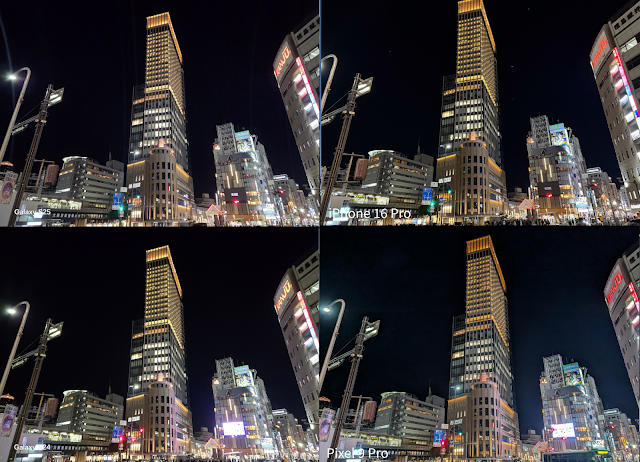
In low-light conditions, the iPhone 16 Pro produces overly warm (yellow) images, while the Pixel 9 Pro leans too cool (blue). The Galaxy S25 and S24 achieve a more balanced color temperature.
The Pixel 9 Pro slightly underexposes night scenes, which helps control lens flare but leaves signage and other elements too dark. The iPhone 16 Pro offers the best overall balance, followed closely by the Galaxy S25, then the Galaxy S24.
Camera System Overall Assessment
The Galaxy S25’s camera system approaches perfection. Despite using the same hardware as the S24, it shows clear evolution with more natural color reproduction and improved handling of challenging lighting scenarios.
As a result, it now competes on equal footing with camera-focused devices like the Pixel and iPhone. It’s impressive that Samsung has achieved this through software optimization while maintaining the compact sensor size that enables the phone’s slim profile.
Of course, the Galaxy S25 camera isn’t intended for professional photography. Its smaller sensor size results in lower detail resolution and more noise compared to the iPhone 16 Pro or Pixel 9 Pro.
But realistically, few users employ smartphone cameras for professional work. At most, they’re capturing moments for viewing on smartphone screens. For this purpose, the Galaxy S25’s camera is entirely competitive with the iPhone and Pixel, despite its $799.99 price point.
Telephoto Performance: Room for Improvement
The one area where the camera system shows limitations is the telephoto lens. The Galaxy S25’s optical 3x zoom combined with digital enhancement to 5x simply can’t match devices with true optical 5x zoom. While Samsung has improved the software processing, the Pixel 9 Pro remains significantly superior at 5x magnification.
I’d welcome improvements to the Galaxy S26’s telephoto capabilities, though it raises the question of whether such enhancements would be worth sacrificing the device’s slim profile and lightweight design. For most users, the current setup likely represents a reasonable compromise.
AI Features: Voice Recorder Summaries Significantly Improved
Among the various AI capabilities, the one I find most practical is the AI summary feature in the voice recorder app. The Galaxy S25 shows remarkable improvement over the S24 in this regard.
When summarizing the same 12-minute news segment, the results were noticeably different. The S25 not only produced more comprehensive text but also delivered greater accuracy compared to the S24, which occasionally included nonsensical statements. Even the processing time was reduced by half.
This feature has reached a level of utility that makes it genuinely valuable for meetings, customer inquiries, and even recalling conversations from social gatherings. It represents AI functionality that delivers tangible convenience rather than mere novelty.
User Experience: Best-in-Class ONE UI Continues to Excel
Samsung’s ONE UI operating system is renowned for its intuitive design—so user-friendly that many find it difficult to switch to other platforms. This exceptional user experience remains intact with the S25.
Even the somewhat controversial separation of notifications and control center in Android 14 can be customized and integrated on the Galaxy S25.
This demonstrates Samsung’s deep understanding of user needs. I hope they maintain this user-centric approach in future iterations.
Additional Features: Screen Output Support
The Galaxy S25 supports external display output, though the practical applications for this feature remain somewhat limited. It’s difficult to imagine many scenarios where you’d have access to a display and cable but nothing else. Nevertheless, it could prove useful in business settings for demonstrating smartphone applications.
I continue to hope for greater compatibility between PC games and Android, allowing smartphones to serve as legitimate gaming platforms. Unfortunately, progress in this area remains slow. With the processing power available in modern smartphones, it’s a shame there aren’t more demanding applications to utilize it.
Conclusion: Galaxy S25 is a Masterpiece of Smartphone Engineering
When first announced, I assumed the Galaxy S25 would offer minimal improvements over its predecessor. However, the actual experience has proven surprisingly different.
The enhanced thinness and reduced weight have a greater impact than expected, prompting frequent appreciation for the device’s ergonomics.
Additionally, the camera’s processing has become more natural and versatile, with notably improved performance in challenging lighting conditions.
Battery life continues to improve with each generation—an impressive achievement.
Gaming performance is absolutely top-tier. In fact, everything about this device represents the pinnacle of smartphone technology. The Snapdragon 8 Elite processor delivers more than enough power for even the most demanding mobile games like Genshin Impact. No smartphone currently offers better gaming performance than the Galaxy S25—almost to the point of excess.
Charging speeds are entirely adequate, and AI features show meaningful evolution. I have no complaints whatsoever. It’s as close to perfect as a smartphone gets in 2025, and I can wholeheartedly recommend it to anyone in the market for a premium device.
The Challenge of Smartphone Evolution
However, as is increasingly common in the smartphone industry, the improvements are incremental. This isn’t a shortcoming of the Galaxy S25 specifically, but rather a reflection of the smartphone market’s maturity.
While the S25 is excellent, the Galaxy S23 remains a highly capable device. For those who scrutinize the details, the two-generation evolution is certainly noticeable, but explaining these refinements to typical consumers who don’t analyze their devices so meticulously is challenging. Most casual users might simply observe that “it’s a bit lighter and thinner.”
When they learn that these subtle improvements come with a $799.99 price tag, the value proposition becomes questionable. Is a 0.18oz weight reduction and 0.02-inch thickness decrease worth the investment? For many, the answer is understandably no.
Market Positioning: The Premium Pricing Challenge
This creates a difficult situation. Despite the Galaxy S25’s technical excellence, it struggles to justify a necessity for many potential buyers.
Furthermore, Samsung’s strategy of discounting the Galaxy S series toward the end of each year diminishes its perceived premium value. Despite offering flawless usability and performance, it can’t command the consistent premium pricing that Apple achieves with the iPhone.
Buying Recommendation
For enthusiasts and those actively seeking a smartphone upgrade, I strongly recommend the Galaxy S25. However, I can’t in good conscience suggest that users of the Galaxy S23 or newer models need to upgrade immediately. For those who aren’t in a hurry, waiting six months may be advisable, as prices will likely decrease.
It’s a peculiar situation—recommending a device that I believe represents the absolute pinnacle of smartphone technology while simultaneously acknowledging that many users won’t find sufficient reason to upgrade. Nevertheless, it truly is exceptional, and I’ll likely purchase the next iteration when it arrives. Samsung deserves recognition for creating this masterpiece that embodies Korean engineering excellence and technological pride.
#galaxys25 #galaxys25review #smartphonereview

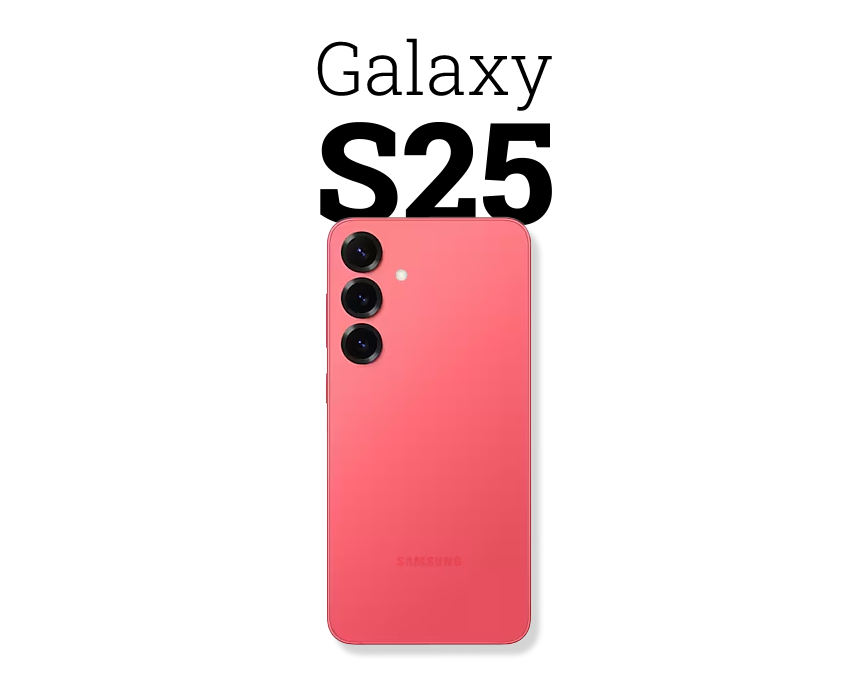
1 thought on “SAMSUNG Galaxy S25 Review”
Comments are closed.